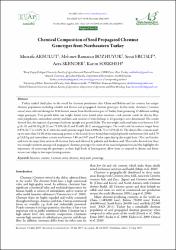Chemical composition of seed propagated chestnut genotypes from northeastern Turkey
Künye
Akbulut, M., Bozhuyuk, M.R., Ercişli, S., Skender, A. & Sorkheh, K. (2017). Chemical Composition of Seed Propagated Chestnut Genotypes from Northeastern Turkey. Notulae Botanicae Horti Agrobotanici Cluj-Napoca, 45(2), 425–430. https://doi.org/10.15835/nbha45210931Özet
Turkey ranked third place in the world for chestnut production after China and Bolivia and the country has unique chestnut populations including valuable and diverse seed propagated chestnut genotypes. in this study, chestnuts (Castanea sativa) were collected during the 2016 harvest season from Northeastern part of Turkey from promising 12 different seedling origin genotypes. Tree growth habit, nut weight, kernel ratio, kernel color, moisture, crude protein, crude fat, dietary fiber, total polyphenols, antioxidant activity and fatty acid content of fruits belongs to 12 genotypes were determined. the results showed that, the majority of genotypes had semi upright tree growth habit. the nut weight and kernel ratio were between 5.05 g (K-10) and 10.10 g (K-5) and 71.10% (K-1) and 82.44% (K-3) among genotypes. the total crude fat content ranged from 0.87% (K-7) to 2.61% (K-1) while the crude protein ranged from 4.80% (K-7) to 7.65% (K-1). the dietary fiber content made up no more than 3.61% of the remaining portion of the kernel. It was found that total polyphenols was between 1.66 and 2.70 g GAE/ kg and antioxidant activity was between 5.80 and 9.07 mu mol Trolox equivalent/ g dry weight basis. Oleic and linoleic acid were the major fatty acids in all chestnut fruits and followed by palmitic and linolenic acid. the results showed that there was enough variations among seed propagated chestnut genotypes for most of the searched parameters and this highlights the importance of conserving the genotypes, as their high levels of heterogeneity allow them to respond to abiotic and biotic stresses and adapt to low-input farming systems.


















